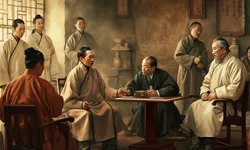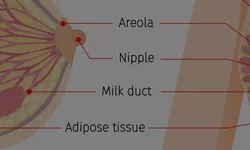Blood
Blood, mainly composed of the nutrient Qi and body fluids, circulates inside the vessels. It is red in color and sticky in texture. Blood functions to nourish and moisten the body. It is vital to the maintenance of life.
The production of blood
The basic substance for producing blood is essence, including the congenital essence (kidney-essence) and the acquired essence (food nutrients). The congenital essence is prerequisite to the production of blood. Only when the acquired essence has combined with the congenital essence can blood be produced. Thus deficiency of kidney essence will make it difficult to produce blood. However, the congenital essence is already fixed after birth. In this case the acquired essence plays a key role in the production of blood. For this reason the functions of the spleen and stomach are key to the production of blood. If the spleen and the stomach are normal in functions, they can absorb sufficient food nutrients to produce blood. If the spleen and stomach are weak in absorbing food nutrients, the production of blood is inevitably reduced
The transformation of the essence into blood is in fact a process of qi-transformation. The organs involved in such a process are the heart and the lung. The function of the heart in the process of blood production is called “reddening”, because the heart pertains to fire in the five elements and red in the five colors. With the action of heart-fire blood becomes red. The lung participates in the production of the nutrient qi by inhaling fresh air from the outside. The nutrient qi is an important component of blood. So the functions of the lung directly influence the production of blood. Besides, the liver regulates qi activity and influences qi-transformation in the whole body with its dredging and dispersing functions, also exerting certain effect on the production of blood.
The physiological functions of blood
The physiological functions of blood are to nourish and moisten the body as described in the Nanjing. Since blood contains the nutrient qi, it can nourish all the organs in the body. Through the meridians, blood transports nutrient substances to all parts of the body to nourish the five zang-organs, the six fu-organs, the five constituents, the five sensory organs and the nine orifices. It should be noted that blood is also the important material base for mental activities. If blood is sufficient, there will be sufficient vitality; if blood is deficient, there will be dispiritedness; if blood is in disturbance, there will be mental disorder. Since blood contains fluid, it can moisten the viscera and the body. When the fluid flows out of the vessels, it moistens the orifices and lubricate the joints.
Besides, blood also transports the turbid qi. When the turbid qi is transported to the lung, it is excreted from respiration. When it is transported to the kidney, it is discharged from urination. When it is transported to the superficies, it is excreted from sweating.
The circulation of blood
The vessels in the whole body form a relatively close circulatory system for blood circulation. Such a system is known as blood vessels in TCM included in the concept of meridians and vessels. The minute capillaries are called blood collaterals.
Blood is propelled by the heart to circulate in the vessels. In fact the heart is the center of the blood circulatory system. In structure, the heart is connected with the vessels. That is why the heart can propel blood to circulate in the vessels. Since the circulation of blood is a circulator process, the directions of blood circulation is either centrifugal or axopetal. The former means that the blood is propelled by heart-qi to flow out from the heart to the whole body through large vessels into large collaterals and fine capillaries. In such a way blood enters the internal organs to nourish and moisten the body. The latter means that blood accumulates from the fine capillaries to the large collaterals and the vessels into the heart under the propelling action of the heart.
Apart from the heart, other internal organs are also involved in the circulation of blood, including the lung, the spleen and the liver. Structurally the lung is connected with all the vessels in the body, known as “the lung facing all the vessels”. With the association with the vessels, the lung distributes nutrient substances, like the pectoral qi, to the whole body and accumulates qi and blood from the whole body to assist the heart to propel blood circulation. The spleen commands blood, making the vessels compact, directing blood to circulate normally in the vessels and preventing it from flowing out of the vessels. The liver stores blood and regulates the volume of blood. Besides, the liver also governs dredging and dispersing, thus smoothing the activity of qi to promote blood circulation.
The factor that directly acts on blood circulation is qi. For example, heart-qi propels blood to circulate; lung qi assists the heart to propel blood circulation; spleen-qi commands blood; and liver-qi regulates the circulation of blood by dredging and dispersing qi. If heart-qi is insufficient, blood will become too weak to circulate; if lung-qi is insufficient, there will be no opportunity for blood to disperse; if spleen-qi is insufficient, it will be difficult for the spleen to command blood; if liver-qi fails to dredge, it will lead to stagnation of qi and stasis of blood. Besides, visceral yang also plays an important role in the circulation of blood. For example, deficiency of yang will inevitably cause deficiency of qi, making it difficult for blood to circulate; deficiency of yin will bring on cold and exuberant cold will coagulate blood.
Other factors that may affect blood circulation are the state of the vessels and the changes of cold and heat. Generally speaking, phlegm, dampness, blood stasis, swelling and nodules can block or compress the vessels and obstruct blood circulation. Blood is characterized by preference for warmth and aversion to cold. So excessive cold slows down the circulation of blood or even causes blood stasis; excessive heat accelerates blood circulation and even leads to bleeding in severe cases.
Body fluid
The basic concept of body fluid
Body fluid is a basic substance that makes up the body and maintains life activities. The main component of body fluid is water, also including nutrient substance. Body fluid is also a component of blood when it flows inside the vessels. However, body fluid also flows outside the vessels in the viscera and the body. If secreting or excreting from the five sensory organs and the nine orifices, body fluid becomes urine, sweat, tears, snivel, saliva, drool, etc.
Body fluid can be divided into two parts: thin fluid and thick fluid which are different from each other in property, location and functions. Generally speaking, thin fluid flows quickly and is distributed in the skin, muscles and orifices to moisten the related parts of the body. The thick fluid flows relatively slowly and is distributed in the viscera, cerebral marrow and joints to nourish the related parts of the body. Though different in texture and distribution, both the thin and thick fluids come from food and water transformed by the spleen and stomach, functionally flowing inside and outside the vessels to permeate and supplement each other. Physiologically they are not strict ly separated from each other; pathologically “ impairment of the thin fluid” is relatively light while “loss of the thick fluid” is relatively serious.
The production of body fluid
The digestive and absorbing functions of the stomach, the spleen and the large and small intestines play a key role in the production of body fluid. Body fluid comes from food, especially water and liquid diet. The production of body fluid comes through a series of physiological activities, including the functions of the stomach to receive and digest, the functions of the spleen to transport, transform and transmit, the functions of the small intestine to receive and digest, and the functions of the large intestine to transmit and change. Different viscera may exert different effect on the water taken into the body. So the metabolism of body fluid is accomplished under the coordination of different viscera.
The physiological functions of body fluid
The physiological functions of body fluid includes the following three aspects.
Moistening and nourishing
Body fluid contains large quantity of water and nutrient substances to moisten and nourish the viscera and the body. To be specific, the thin fluid, distributed in the skin and orifices, mainly functions to moisten the body; the thick fluid, distributed in the viscera and cerebral marrow, mainly functions to nourish the body.
The transformation of blood
Body fluid not only flows outside the vessels, but also inside the vessels to participate in the production of blood. Blood is composed of two parts: body fluid and the nutrient qi. If body fluid is insufficient, the production of blood will be reduced, leading to blood deficiency.
The transportation of the turbid qi
Body fluid can hold various turbid qi and waste materials produced by qi-transformation and transport them to the concerned organs to be excreted out of the body through urination, sweating and respiration. The waste materials and the turbid qi are directly excreted in the form of fluid through urination and sweating. But the turbid qi excreted through respiration is transported to the lung first by body fluid and then exhaled out of the body. If body fluid is insufficient, the turbid qi cannot be quickly excreted out of the body, seriously affecting qi-transformation and causing various pathological changes.
The transportation and metabolism of body fluid
The transportation and metabolism of body fluid are complicated, involving the physiological activities of several viscera. Body fluid, produced by the spleen and the stomach to absorb water and nutrients from food, is transported to the heart and the lung by the spleen to start its metabolic process. The viscera concerned with the metabolism of body fluid mainly include the spleen, the lung and the kidney as well as the heart, the liver, the bladder, the large intestine and the triple burner.
The spleen, the lung and the kidney play a key role in the transportation and distribution of body fluid. The spleen, governing transportation and transformation, transports body fluid to the heart and the lung; the lung governing the regulation of water passage, transports body fluid to the whole body and down into the kidney; the kidney, governing water and separating the clear from the turbid, again transports body fluid that is steamed and qi-transformed during the formation of urine into the heart and the lung. In propelling the circulation of blood, the heart also promotes the flow of body fluid.
In this way body fluid is transported to the whole body to nourish the five zang-organs and the six fu-organs. After being used, the rest of water and the waste metabolic materials are excreted out of the body through certain routes. The excretion of body fluid involves the lung, the kidney, the bladder and the large intestine. Lung-qi, governing dispersion, depuration and descent, excretes the fluid from the skin and respiratory tract and excretes the fluid together with feces from the large intestine.
Kidney- qi, governing water, transforms the fluid into urine to be excreted as urine from the bladder. Among these different routes, urination and sweating are the major ones for the excretion of the fluid. Only part of the fluid is excreted through defecation and respiration.
Besides, the liver and the triple burner also play a certain role in the distribution and excretion of body fluid. Liver-qi, governing dredging and dispersing, promotes the flow and metabolism of body fluid by means of regulating the activity of qi; the triple energizer, serving as a water passage directs body fluid to flow downward through it to the kidney. In the whole process of the flow and metabolism of body fluid, the triple burner, connecting the upper with the lower, participates in the whole process of the production, distribution and excretion of body fluid. To be specific, the upper burner participates in the distribution of body fluid as implied in the idea that “the upper energizer is like fog”; the middle burner participates in the absorption of body fluid as implied in the idea that “the middle energizer is like maceration”; the lower energizer participates in the excretion of body fluid as implied in the idea that “the lower energizer is like a sewer”
On the whole, the flow and metabolism of body fluid involve several viscera, but the lung, the spleen and the kidney are the most important ones. So the dysfunction or hypofunction of these three organs will affect the flow and metabolism of body fluid, leading to phlegm, retention of fluid and edema.
The five zang-organs transforming five kinds of liquids
The five kinds of liquids include sweat, snivel, tear, saliva and drool. TCM believes that these liquids are transformed by the five zang-organs.
The relationships between the five zang-organs and the five kinds of liquids are described this way: sweat is the liquid of the heart, snivel is the liquid of the lung, tear is the liquid of the liver, saliva is the liquid of the spleen and spittle is the liquid of the kidney.
- Sweat comes from body fluid and is excreted out of the body through sweat pores under the steaming of yang-qi. The heart pertains to fire in the five elements. Heart-fire transforms into yang-qi to steam body fluid which comes out of the skin and becomes sweat. Thus sweat is regarded as the fluid of the heart. Insufficiency of heart-yang results in oligohidrosis while superabundance of heart-fire brings on polyhidrosis.
- Snivel refers to the nasal mucus that can moisten the nostrils. Since the nose is the orifice of the lung, so snivel is the liquid of the lung. If lung-qi fails to disperse the nose will become stuffy and running; if lung-heat impairs body fluid, the nose will be dry with scanty snivel.
- Tear comes from the eyes and can moisten the eyes. Since the eyes are the orifices of the liver, the tear is certainly the liquid of the liver. If there is wind-heat in the liver, the eyes will become tearing; if liver-yin is insufficient, the eyes will become dry because of scanty tear.
- Saliva refers to the thin part of the fluid in the mouth. It can promote the intake of food. Since the mouth is the orifice of the spleen, saliva is the liquid of the spleen. If the spleen is weak, there will be profuse of saliva running out of the mouth; if spleen-yin is insufficient, the mouth will be dry because of scanty saliva in the mouth.
- Spittle refers to the thick part of the fluid in the mouth. It can moisten the mouth and the tongue. TCM believes that saliva is produced at the mouth corners and spittle is produced under the tongue. Since the sublingual vein is connected with the kidney meridian, spittle is the liquid of the kidney. In terms of life cultivation, TCM holds that spittle is transformed from kidney-essence.That is why masters of life cultivation advocate to swallow spittle in order to enrich kidney-essence and cultivate health. If kidney-essence is deficient, spittle will become scanty and the mouth will become dry.
The relationships between blood and body fluid
Qi and blood and body fluid are basic substances that maintain life activities. These two substances can transform into each other through qi-transforming activity and depend on each other in physiological functions. If one of them has changed, the other will make corresponding reactions. Such an inter-dependent relationship among them is not only signified in physiology, but also in pathology. Clinically the regulation of this inter-dependent relationship is very important in treating diseases.
Both blood and body fluid are liquid substances and function to nourish and moisten the viscera and the body. Compared with qi, both blood and body fluid pertain to yin. Physiologically blood and body fluid depend on and transform into each other. Pathologically, blood and body fluid affect each other.
Blood is made up of body fluid and the nutrient qi. After the transformation by the spleen and stomach, body fluid is transported first to the vessels and then flows with blood to the whole body. Part of body fluid extravasates from the vessels and flows outside the vessels to moisten and nourish the viscera and the body. At the same time part of body fluid flowing outside the vessels enters the vessels again to participate in the production of blood. In fact, body fluid inside and outside the vessels frequently transforms and supplements each other. Normally there is a dynamic balance maintained between them. Under pathological condition, if great quantity of body fluid is consumed or if great amount of body fluid comes out of the vessels, it will lead to insufficiency of blood inside the vessels. On the contrary, if too much body fluid outside the vessels enters the vessels because of massive hemorrhage, it will lead to insufficiency of body fluid. As a result, a morbid state of scanty fluid and dryness of blood is caused due to insufficiency of body fluid and blood.
Sweat, transformed from body fluid, is closely related to blood. Blood deficiency, usually followed by insufficiency of body fluid, cannot be treated simply by diaphoresis because profuse sweating consumes body fluid and further aggravates the deficiency of blood. On the other hand, profuse sweating and scanty body fluid, often accompanied by insufficiency of blood, cannot be simply treated by blood-breaking therapy because excessive bleeding exhausts the blood and further aggravates the scanty state of body fluid. That is why it is said in Lingshu that “ the patients with massive bleeding cannot be treated by diaphoresis while the patients with profuse sweating should not be treated by bloodletting therapy.” Blood and body fluid not only depend on and transform into each other, but also share the same origin. That is to say that both of them come from the food nutrients. Such a relationship between blood and body fluid is generalized as “body fluid and blood sharing the same origin” in TCM.








